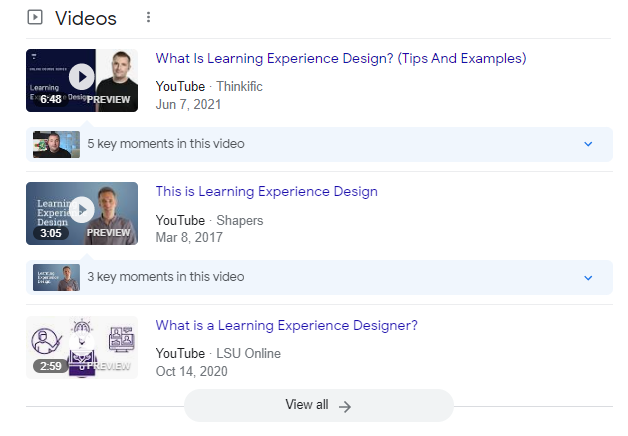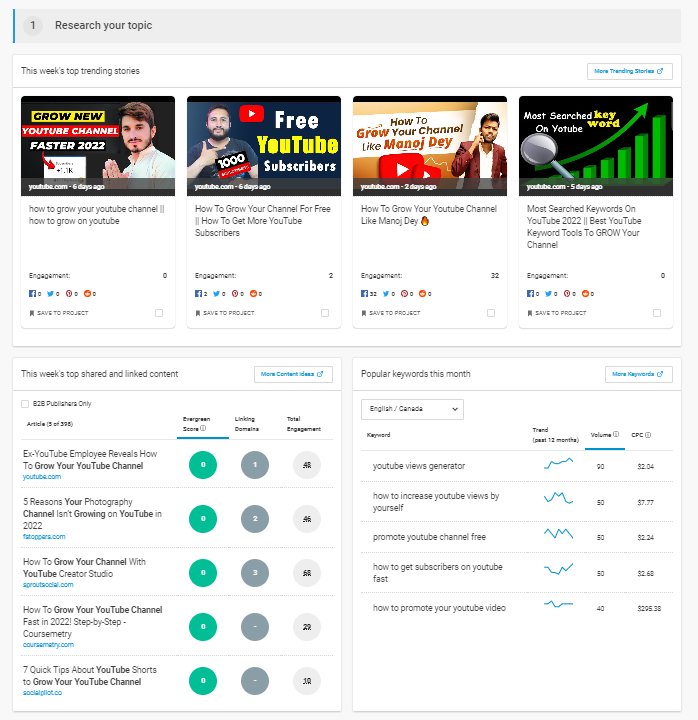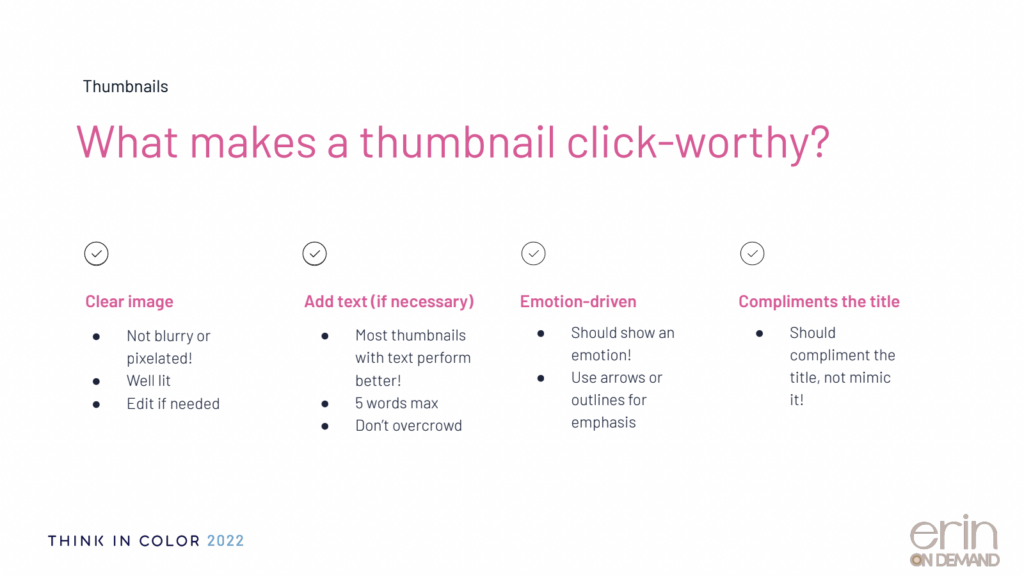Congratulations! You’ve created your Youtube channel, and now you want to grow. Growing your YouTube channel and subscriber count is a massive undertaking that requires a lot of thought, preparation, time, and effort.
New creators spend months, even years, trying to grow on YouTube but never make significant progress. What are they missing? Hint: A Strategy.
Here’s a detailed guide on how to grow your YouTube channel with a successful strategy, with insights from YouTube experts, Dan Currier and Erin On Demand.
Skip ahead here:
- The basic pillars of growing a youtube channel
- 9 strategies that will make your youtube channel grow
- What Does your Target Audience Want/Need?
- Optimize Your Content for Search
- Create Valuable Content
- The Great Debate: Quality vs Quantity
- Consider Your Kairos (timeliness)
- Make The Right First Impression With Metadata
- Use Cohesive Branding
- Include a Call to Action (Why all youtubers use “like and subscribe”, “hit that bell!”)
- Growing Off Platform
- YouTube Growth Workshop
The basic pillars of growing a youtube channel
It’s easy to be dazzled by the glamour of a successful YouTube channel. YouTube “stars” often make growing a Youtube Channel look so simple that it can be easy to forget how hard growing a channel actually is.
Whether you’re wondering how to create a YouTube channel or want to grow your subscriber count, it’s important to start with the basics first.
The marathon mindset: three keys to playing the long game to grow your channel
YouTube expert, Dan Currier from Creator Essentials recommends that you need to view your YouTube strategy not as a destination, but as a process that’s constantly improving. Here are three tips dan on the marathon mindset.
- Persistence
Once you get started, you want to continue creating content. Don’t get distracted or think that you’re not making any progress and decide to give up before results start to show.
- Consistency
Be consistent in the way you approach your content creation and how frequently you share it. You also want to show up as consistent in your branding and in the overall message that you’re sharing.
As part of this, you’ll need to decide what’s realistic for you in ensuring you can stick to the schedule for the long term. You don’t want to let your ambitions get the better of you, and end up burning yourself out trying to pump out a ton of content that saps away your soul. Remember, it’s about the long-term, not the short-term (i.e. the marathon mindset).
- Patience
Often people idolize the results they see other people achieve, without realizing the work, effort and time it takes to get there. In the case of YouTube content creators, it’s tempting to get impatient seeing everyone else seemingly grow their audience and monetize their channel.
Rather than playing the comparison game by obsessing over metrics such as subscribers and views, Dan recommends that YouTube creators focus on getting 100 videos out on the platform.
Related YouTube Video: How to grow with 0 views and 0 subscribers (secrets revealed!)
9 strategies that will make your youtube channel grow
There are 5 essential elements to consider when creating videos. They are search engine optimization (SEO), metadata, value, branding, and the call to action. Let’s look at how each one can help you grow your YouTube channel.
1. What does your target audience want/need?
The first step to offering value is understanding what your audience wants or needs. If you aren’t giving viewers what they need or want, they won’t stick around for the video and probably won’t come back. That’s why SEO is so important.
If you’ve isolated a list of long-tail keywords for a single topic, and they all have high search volume and low competition, then you already know there’s an audience for that content. The search volume indicates that your audience is searching for the content (they need/want it), and the low competition suggests that there’s room for you to move in and win over viewers with your title and thumbnail and then the video. Focus on content that solves problems and answers frequently asked questions. Once you’ve mastered that, you can branch into offering value in other ways.
Autience research templates
Here are a few Audience Research guides, with downloadable worksheets that can help guide you understand your audience better:
- How To Define Your Target Audience (+Templates & Workbooks)
- How To Create Your Ideal User Persona To Focus Your Efforts (+3 Templates)
- Customer Avatar Workbook
Turning your audience needs into evergreen content ideas
Using the insights you uncovered about your audience, make a list of all the questions your audience is asking, and answering those questions.
If you pick evergreen topics that people always search for, you will need to spend less time actively promoting your content to generate views and subscribers!
Pro Tips on determining demand for evergreen content from our course creation guide:
- Answer The Public is a helpful way to find out what people are asking about a topic
- Try searching your potential topic on Reddit or Quora or to see what comes up, and how often
- If you’re in any Facebook groups, or better yet, you run one – scroll through and use the search function to gain some insight into the challenges your potential audience has. (AKA social listening)
2. Optimize your content for search
People typically think of SEO when trying to rank on Google search. But Google isn’t the only search engine. YouTube is also a search engine, (TikTok, and Reddit are too!).
That means a complex algorithm runs behind the scenes and determines which videos to put in front of viewers.
If you put hours of effort into creating videos for YouTube, you want to ensure those videos get watched! And while this can’t make your channel followers grow directly, SEO can help you set a strong foundation and increase your chances of showing up within YouTube and Google Search to get in front your audience.
An example… Thinkfic’s blog post on Learning Experience Design has a YouTube video embedded on it; and this video ranks on google as a Video Search Result:

Video SEO in a nutshell
If you’re not familiar with SEO, here’s a few basic terms to get you started:
- Keywords – A keyword is a word or phrase that a viewer types into YouTube. An example of a keyword is “plant.”
- Short-tail Keywords – A short-tail keyword (also called a seed keyword or head term) is a short search phrase and usually has 1-3 words. An example of a short-tail keyword is “pothos plant.”
- Long-tail Keywords – A long-tail keyword is a long search phrase that has 4 or more words and may even make a complete sentence. An example of a long-tail keyword is, “How much water does a pothos plant need?”
- Rank – Rank refers to where your video occurs on the search page. Ranking at the top will mean more viewers see your video, and you’ll have a higher chance of earning those viewers. The higher you rank, the better.
- Search Volume – Search volume refers to how many people are searching with your keywords. For example, the search volume for “pothos” will be much higher than the search volume for “growing a pothos plant in Alaska.” The more specific you get, the fewer people there are searching for your phrase.
- Low/high Competition – Low and high competition refers to how much content already exists for that keyword. The shorter your keyword, the more likely it is that content already exists for it. We recommend beginning with short-tail keywords and brainstorming your long-tail keywords around that central topic. Search for keywords with relatively high search volume and low competition because that means people are searching for your phrase, but there isn’t much content available. They’ll be much more likely to click your video if it’s relevant and valuable to their search terms.
You can use a keyword tool, like Google’s free Keyword Explorer tool, UberSuggest to figure out how many people are searching for a topic
Whether you already have keywords or you’re trying to find some, tools like VidIQ and TubeBuddy can help you understand which words to target, how many people are searching for those keywords, and how hard it will be to show up at the top of YouTube search results.
To grow your YouTube channel, search engine optimization can inform every part of your video. From the thumbnail and title to the actual words you say, YouTube is analyzing your content and deciding who to recommend it to.
Related article: How to Create a YouTube Channel
Make money from your video content (without the cost or loss of control)
Sign up for Thinkific’s free plan to share your knowledge and generate revenue from your video content — all from a single platform that you control.
3. Create valuable content
Starting your creative process with a proper SEO strategy can help to grow your YouTube channel fast, but SEO on its own isn’t enough. The next thing you need to do before you even hit the record button is, determine how you will deliver value in your content and throughout your channel.
Instead of just ‘winging it’ by picking up a camera and shooting whatever comes to mind, it’s important to focus on understanding exactly what your audience needs or wants, and deliver that to them.
Focus on solving problems and answering common questions – once you have a good idea of how to do those, you can start shooting your videos and teaching online.
And in due time, you’ll not only grow your audience. You’ll also establish yourself and your personal brand as an authority in your space.
Related article: The Complete Guide to Epic Content Creation for Entrepreneurs
4. The great debate: quality vs quantity
When it comes to value and YouTube, you have to consider the quality of your videos. So many people let quality restrict quantity. Don’t spend so long trying to achieve the perfectly edited video that you can only publish one video a month.
“Start scrappy, not crappy.”-Erin from of Erin On Demand
Finding the right balance of quality and quantity can be challenging, especially for new creators. The trick is not to let quality keep you from producing any content. If 8 hours of editing makes you dread creating a video or keeps you from publishing 4 videos a month, then ditch a few time-consuming elements.
Over time, you’ll learn how to edit YouTube videos professionally and efficiently. Right now, your focus is to publish content at whatever level of quality you can manage and to grow from there.
5. Timeliness (Consider your kairos)
Have you ever heard a joke in poor taste and thought too soon? That joke wasn’t timely. Greek has 2 words for ‘time.’ Chronos, which represents the word time as we know it, is the one most people recognize. The other is kairos, which means timeliness. You should always consider the timeliness of your content.
Timeliness is important when it comes to value because untimely things don’t hold much value. That joke in poor taste wasn’t funny; it had no value for its listeners. There are 3 major categories when it comes to timeliness and value in your YouTube content: Evergreen, Seasonal, and Timely content.
- Evergreen Content – Evergreen content gets its name from evergreen trees. Like the trees, there really isn’t aright season for this content. It doesn’t fade in or fade out. It’s always relevant.
- Seasonal Content – Seasonal content is content that has seasons or annual timing. Seasonal content can include Christmas content like “Christmas party games for the whole family” or New Year’s content like “How to make a New Year’s resolution and stick to it.” It could also literally refer to seasons. Think summer snacks or winter style. These things come and go, but the right content can be valuable year after year because it doesn’t follow a fad or trend.
- Timely Content – Unlike evergreen and seasonal content, timely content is always short-lived. That doesn’t mean it doesn’t have value, it just means it won’t have value for long. Video trends, challenges, and current events are all examples of timely content.
No one particular style of content is better or worse. When you’re first trying to grow your channel, a healthy mix of content can help you gain followers on YouTube. Timely content can be beneficial if you’re able to create and publish quickly because you might be able to rank on YouTube when search volume is high and competition is low. On the other hand, high-quality evergreen content will give you lasting results for years to come.
6. Make the right first impression with metadata
Metadata sounds like a complex technical term, but you can think of it as a first impression. YouTube metadata includes your title and thumbnail. These are the first things a viewer will see on YouTube. It’s your first chance to make an impression and drive them to click your video.
When you’re thinking about metadata, you have to consider your viewers and YouTube itself. Like your human viewers, YouTube will use your title and thumbnail to get an initial understanding of your video. It uses that understanding to show your video to the viewers it thinks want to see your content. If your metadata gives YouTube the wrong impression or doesn’t match what searches need and want, it will be hard to grow. So let’s talk about each of the 3 metadata elements in more detail.
Title
Once your thumbnail has attracted someone’s attention, they’re going to look at your title. How you approach your video titles will vary based on your niche, your audience, and the overall mood of your content, but some things apply to almost everyone.
A good title will:
- Be engaging and catchy – Your title should engage your target audience. Whether your video is about the perfect desk setup for gaming or an unsolved mystery, the words you use to grab attention should invite viewers to click and find out more without being clickbait.
- Be optimized for SEO with keywords – Your SEO keywords should make an appearance in your title. The title can feature the seed keyword, or it can make use of the full long-tail keyword. Use what feels natural and makes sense.
- Be brief but descriptive – Your title can use up to 100 characters, but Erin recommends staying with 50-60 characters. Use these few characters with colorful, emotional, and descriptive words.
Pro Tip: You can use a tool like BuzzSumo to search a topic, for the competition and latest content, including titles and engagement of prominent content on the web.

Thumbnails
Your video thumbnail is the first thing many viewers will see. Thinkific customer and content strategist Erin Winters White of Erin On Demand grew her YouTube channel to over 300K subscribers in just 3 years.
Here’s an example of Thumbnail images used on Erin’s channel:

In a recent webinar as part of Think In Color 2022, Erin discussed 4 essential elements that make a thumbnail click-worthy.

#1 Clear Image
Whether your thumbnail has one image or multiple, each picture should be clear. If your thumbnail is low quality, viewers will assume your video will be too.
Don’t be afraid to edit your thumbnail after you’ve published the video. Experiment with different thumbnails and find what works best for your channel.
#2 Text
Adding text to a thumbnail can help viewers quickly understand what your video is about. Text can also grab their attention. But, only add text if it makes sense. If you add text to your thumbnail, limit it to 5 words max. Just like blurry images, overcrowded thumbnails don’t represent quality content.
#3 Emotion and Movement
If you’re featured in the thumbnail, don’t be afraid to show emotion. The mood you set for your video will affect the performance of your video. Clothes, makeup, and hairstyles also contribute to the mood of your video. Make sure you consider these as you make your thumbnail and video.
You can also use movement in your thumbnail. Yes, movement. Think about how a viewer’s eye will move across the screen when they look at your thumbnail. Elements like arrows, circles, and colors can lead the viewer to focus on one element or move from one element to the next. Use movement to draw the reader in and stoke their interest.
#4 Compliment the Title
Of all your metadata, your thumbnail might be working the hardest but don’t forget that your metadata all works in unison. Craft a thumbnail that compliments your title. Your viewers will look at both, so use this as an opportunity to share more information about your video rather than sharing the same info twice.
And lastly, remember your mobile viewers as you create your thumbnail and title. Everything is smaller on a smartphone. They’ll likely move on if your text is too small to read or your title too long to show up on-screen.
“The thumbnail is the most important part to getting people to click on your videos.” -Erin Winters White of Erin On Demand
Related article: How to Edit Your YouTube Videos in 2022
7. Use cohesive branding
So far, we’ve looked at SEO strategy, putting value into everything you do, and creating strong metadata (thumbnails and titles). Now let’s look at the bigger picture, your YouTube channel as a business (or an extension of).
Whether you’re looking to build a personal brand or a separate business brand, the major elements we’ve discussed today contribute to your brand. Often people think of branding as a logo and a color palette, so let’s start there.
- Colors
Consistently using the same colors can make it easy for people to spot your videos. Colors influence how people learn, feel, and react. If you’re new to YouTube, it’s okay to experiment! Determine what colors make the most sense for your brand.
Here are some things to keep in mind:
- Avoid Red, black, and white. Using one or two of these colors is okay, but avoid using all three if you can. These are the YouTube brand colors, and you don’t want your thumbnails to blend in with the platform. You want them to stand out.
- Use colors that make sense for your niche, even if you don’t like them. For example, you may love the contrast between lime green and black. But if you manage a yoga channel, the intensity of lime green might not fit the vibe of your channel. Consider colors that people regularly use in your niche. For yoga, that would be soft and muted neutrals, blues, greens, and purples, not lime green.
Related article: How to Make a Good YouTube Banner (Tips, Examples & FAQs)
- Typeface
People often use typeface to refer to fonts, but it also includes line spacing, character spacing, alignment, slope, and weight. Just like colors, your typeface has the power to set a visual mood too. Again, you’ll want to consider your niche and audience when setting up your brand typeface.
- Logo and Elements
A logo can easily represent a brand but finding the perfect logo is tricky. You’ll want to stick with something versatile and can be easily viewed on mobile, in a small profile image, or across your channel header. You can create your own with a tool likeCanva or outsource the task to a professional designer on a site like Fiverr.
Similar to a logo are the elements you use in your videos. This can range from the bell icon you use for your invitation to subscribe to the flowers in the corner of your intro. People will recognize your content more easily if you can use the same graphic design elements and style throughout your channel.
Read more: How to Define Your Brand Purpose
8. Include a call to action (Like and Subscribe, Hit that bell!)
A call to action (CTA) is something you include that encourages a viewer to act. If you’ve seen a YouTube video, you’ve probably seen multiple CTAs. “Click the link in the corner,” “hit that bell,” “make sure to hit subscribe,” and “What do you think? Let me know in the comments,” are all CTAs that YouTubers use to appease the algorithms.
Creators use CTAs to get viewers to engage with their content. Engagement on YouTube can take many forms. Simply watching a video is a form of engagement that YouTube measures as “watch time” or “watch duration.”
Comments, likes, dislikes, subscribes, and even clicks are also engagement. YouTube uses engagement to measure how valuable your video is for viewers. YouTube recognizes likes, comments, subscribes, and long watch times as indicators of valuable content.
Ultimately, YouTube wants to match the searcher (viewer) with the information they’re looking for. So if people click on your video and engage, YouTube will likely show your video to more people.
Because your goal is to grow your YouTube channel, you should add CTAs that drive your viewers to engage. Turn your viewers into subscribers by asking them to subscribe. Promote your channel as well as other videos. A viewer will likely find your whole channel valuable if your content is founded on a valuable SEO-driven strategy. You have nothing to lose by incorporating CTAs in your YouTube videos but everything to gain.
Related Article: How Much Money Do You Get Per View on YouTube?
9. Growing off platform
The 5 basic elements we’ve just looked at focus on things you can achieve while working on your channel on the YouTube platform. Let’s look at what you can do outside the platform and in collaboration with other creators.
- Cross-Promote
You should already be promoting your videos inside other videos. For example, if you have a video on how to water a pothos plant, you could recommend viewers check out your video on the best soil for a pothos plant. It’s time to take it one step further.
A content marketing strategy is crucial for continued growth. Like blog posts, TikToks, and even books, YouTube channels can grow faster when you promote them on other platforms. Creators often use social media marketing and email marketing to cross-promote.
Social media marketing can include platforms like Reddit, Instagram, Facebook, Twitter, Snapchat, and Pinterest. Consider tweeting before, the day of, and after you publish a new video. Find subreddits that ask questions you answer in your content and share a link. There are tons of ways you can engage people on social media and guide them to your channel.
Email marketing requires a little more effort to build and maintain, but it too can help you share content with your followers. It will also give you a more direct line to your followers because you can engage with them right in their inbox.
These cross-promotion methods allow you to drum up excitement and engagement for your YouTube channel, which can help you grow your YouTube channel faster and faster.
| Pro tip: Try out this trick for linking from your website to your channel. Add “?sub_confirmation=1” to the end of your channel URL using your Channel ID, like this: www.youtube.com/channel/UC-L9VhnphHLP2hwjRXcj9VQ?sub_confirmation=1 Anyone that clicks the link will see a popup to subscribe. Try it out! |
- Extend your Reach
Cross-promoting your videos will extend your reach only to your current audience. You may have followers on Twitter or LinkedIn that don’t subscribe to your YouTube channel, and cross-promoting can bring them over. The natural next step is to reach even further with collaborations.
You can collaborate with whoever you want, but it’s best to be strategic. If you collaborate with other YouTube creators, choose people with an audience that will benefit from discovering you. Perhaps you’re a digital nomad traveling the country with your dog. Collaborating with a channel that focuses on dog trainingcould make sense, but if your target audience is marketing professionals, it would make more sense to collaborate with a creator that has a channel on working remotely in marketing.
Brand collaborations are also a form of collaboration that can help your channel grow. If you’ve reached a point in your growth where it’s possible, look for collaborations where the brand will share your content with its audience. If the brand is in a similar industry and niche as you, their consumers will likely be interested in your content, making them a great audience to tap into. YouTube ads are one revenue stream but brands are often willing to pay successful creators for collaborations, making brand collaborations an additional way to monetize your channel.
So, What’s Next?
Now that you’re a YouTube growth expert, you’re ready to take on new challenges and scale your online presence even more. After you’ve grown on YouTube you can begin to grow your monetization strategy too. Consider creating online courses that share even more information with your growing audience. Thinkific is a great tool that will help you create, market, and sell your expertise all in one place.
Make money from your video content (without the cost or loss of control)
Sign up for Thinkific’s free plan to share your knowledge and generate revenue from your video content — all from a single platform that you control.
Try Thinkific for free and get the course creation, marketing, and selling tools you need to turn your YouTube channel into a rock-solid business. (No tech skills required!)
YouTube Growth Workshops
Still want to learn more? These recorded webinars will quench your thirst for YouTube growth strategies
The Marathon Mindset to Growing a YouTube Channel
Watch this workshop by Dan Currier on key pillars and strategies on how to grow your YouTube Channel
How to grow with from scratch with 0 views and 0 subscribers (secrets revealed!)
Ready to grow from zero views and zero subscribers on YouTube? Sunny Lenarduzzi created a video for you to grow your YouTube from ZERO, with eleven tips that are not your average.
This article was originally published July 2019, and was updated August 2022 to be even more useful.








